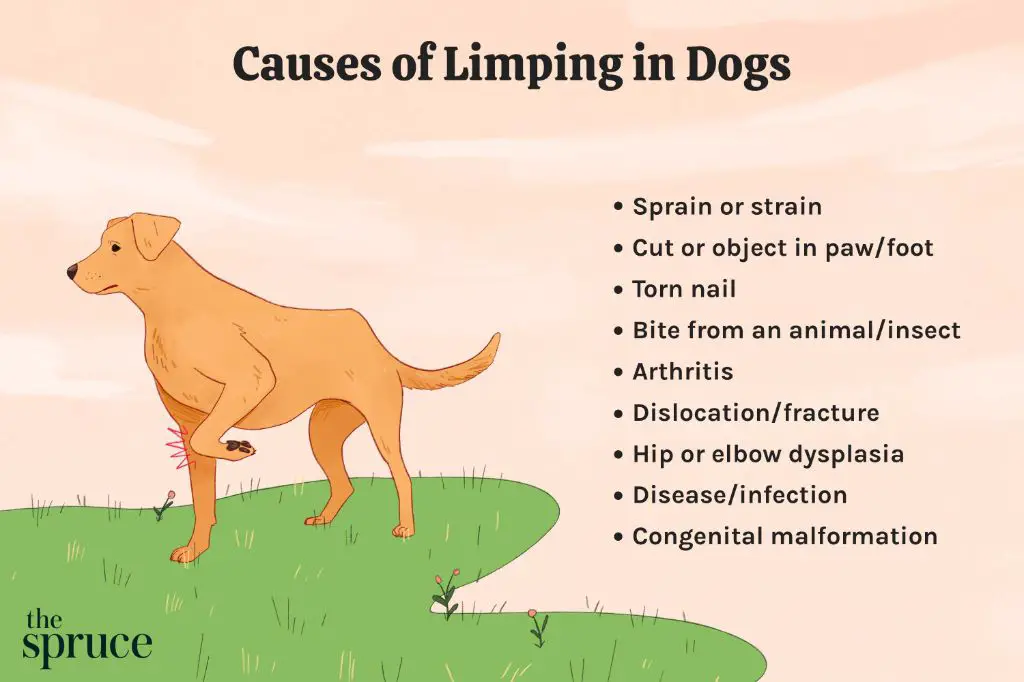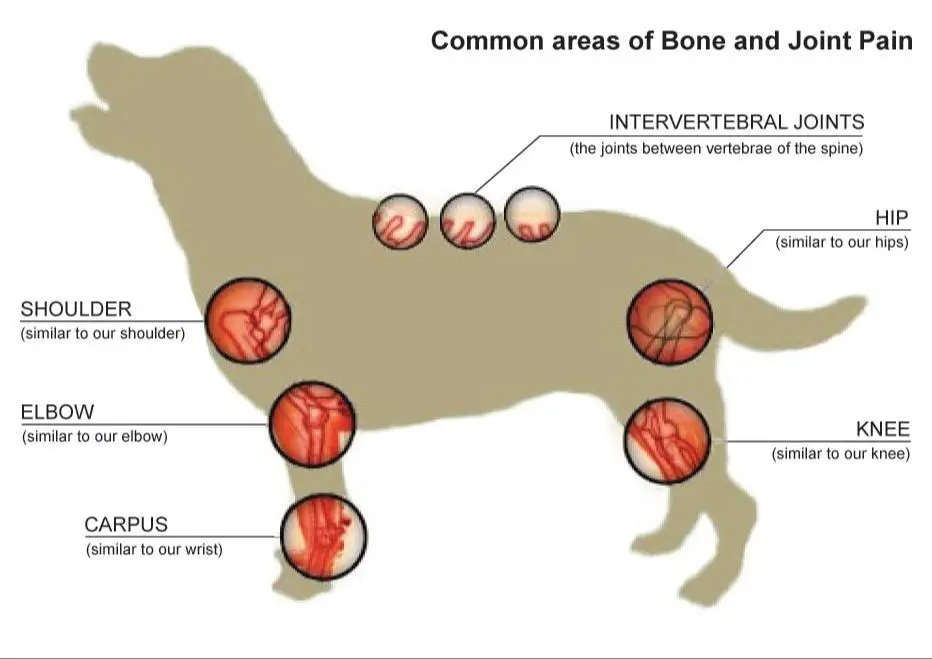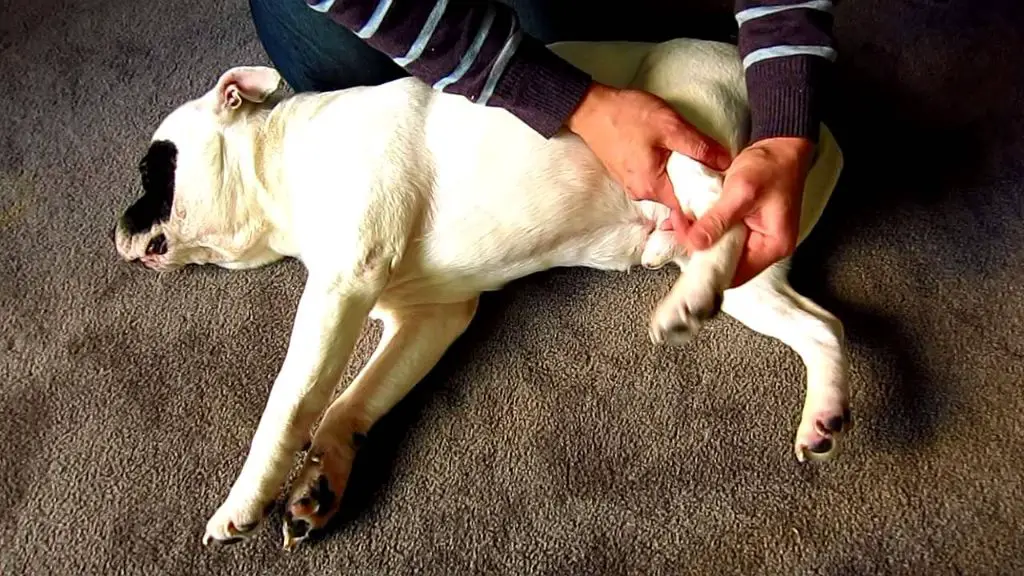Introduction
A dog limping on their front left leg can be alarming for any pet owner. While there could be many reasons for this limp, it’s important not to panic. Limping indicates some type of pain or discomfort in the leg that causes your dog to avoid bearing weight on it. By understanding the possible causes and seeing your vet for a thorough exam, you can get to the root of the problem and help your dog regain normal function of their leg.
Possible Causes
There are several possible causes for a dog limping on their front left leg:
Injury
An injury such as a sprain, strain, or fracture can cause limping. Dogs can injure themselves playing, jumping, falling, or being stepped on. Injuries often cause sudden onset of limping.
Arthritis
Arthritis is inflammation of the joints and is common in older dogs. It causes stiffness, swelling, and pain that can lead to limping. Arthritis usually comes on gradually.
Elbow Dysplasia
Elbow dysplasia is an inherited condition where the elbow joint develops improperly, leading to arthritis. It is most common in larger breed dogs. Elbow dysplasia can cause limping and lameness.
Ligament or Tendon Injury
Damage to ligaments or tendons around the elbow or shoulder from injury or overuse can also cause front leg limping. This includes injuries to the biceps tendon or collateral ligaments.
Injury
One common cause of front leg limping in dogs is injury. Some injuries that can lead to limping include:

-
Fractures – Broken bones in the leg, paw, or toes can cause limping. Fractures may be caused by trauma like being hit by a car or falling. They require veterinary treatment like casts or surgery.
-
Sprains – Sprains are tears or overstretches of ligaments and tendons. Sprains in the wrist, knee or ankle can cause limping. They are often caused by twisting motions and high impact injuries.
-
Torn foot pads – Ripped foot pads are painful injuries usually caused by running on rough surfaces. Deep tears may require stitches and cause limping.
Injuries like these cause inflammation, pain, instability and lameness. Seeing a vet for an exam and x-rays can determine the exact injury. Rest, medication, splints, surgery or physical therapy may be needed for treatment.
Arthritis
Arthritis is inflammation of the joints that can cause limping or lameness in dogs. It often occurs as dogs age, just as it does in humans. Arthritis is very common in dogs, with some estimates indicating up to 20% of dogs develop arthritis at some point in their lives.
Arthritis most frequently affects the elbow, knee, hip and hock (ankle) joints. These joints have the most motion and weight bearing responsibility in the body. Over time, normal wear and tear on the cartilage in these joints can lead to arthritis.

Certain dog breeds are prone to developing arthritis due to conformational factors. For example, hip dysplasia can lead to arthritis in breeds like Labrador Retrievers and German Shepherds. The extra motion caused by a shallow hip socket results in abnormal wear on the cartilage. Other breeds prone to elbow arthritis include Bernese Mountain Dogs and Chow Chows.
Obesity is another major risk factor for arthritis in dogs, as the extra body weight adds more strain on vulnerable joints. Keeping your dog at an optimal lean body weight is one of the best ways to prevent arthritis from developing or worsening.
Elbow Dysplasia
Elbow dysplasia is a common cause of front leg lameness in large and giant breed dogs. It occurs when the elbow joint develops abnormally, leading to joint laxity, osteoarthritis, and loss of cartilage. Certain breeds like Labradors, Golden Retrievers, Rottweilers, and German Shepherds are more susceptible to elbow dysplasia due to their genetic makeup.
Elbow dysplasia is not one single condition, but rather a general term for several growth disorders that cause elbow joint deformity. The main abnormalities seen are fragmentation of the medial coronoid process, osteochondritis dissecans (OCD), and ununited anconeal process. These conditions lead to instability, cartilage damage, and arthritis in the elbow.
Fragmentation of the medial coronoid process involves a piece of bone breaking off inside the elbow joint. OCD occurs when cartilage loses blood supply and cracks, forming bone chips inside the joint. An ununited anconeal process means the elbow bone doesn’t properly attach to the ulna bone.
Any of these conditions can cause lameness, pain, and stiffness. Dogs usually show signs before one year of age. Both elbows are often affected. Without treatment, elbow dysplasia leads to progressive joint damage, worsening arthritis, and loss of limb function.
Ligament or Tendon Injury
Ligaments and tendons connect bones to other bones and muscles. Like any other connective tissue in the body, they can become injured or inflamed. Tendinitis or strains of the ligaments or tendons are common injuries that can cause limping. Some potential issues include:
– Strained shoulder ligaments or tendons – The shoulder has many ligaments and tendons that stabilize the joint and attach the leg to the body. Overuse or injury can cause strains, sprains or tears.
– Ruptured cranial cruciate ligament – This is similar to an ACL injury in humans. This ligament stabilizes the knee joint. When ruptured, it causes instability, inflammation and limping.
– Tendinitis – Inflammation of a tendon. Most commonly affects the tendons around the toes, ankles and shoulders resulting in limping.
– Bicep tendonitis – Inflammation of the bicep tendon that attaches the front leg muscles to the shoulder. Causes limping and front leg lameness.
– Patellar tendinitis – Inflammation of the patellar tendon that connects the knee cap to the shin. Causes limping on the affected leg.
Diagnostic imaging such as x-rays, MRI or ultrasound may be needed to evaluate ligament and tendon injuries. Treatment usually involves rest, anti-inflammatory medication, physical therapy, or surgery in severe cases.
Nerve Damage
Nerve damage, also known as neuropathy, is another potential cause of your dog limping on their front left leg. The nerves in your dog’s legs send signals from the brain to the muscles to control movement and coordination. If these nerves become damaged or compressed, it can disrupt normal communication and cause weakness, pain, and limping.
There are a few ways nerve damage can occur in dogs:
- Trauma or injury, like a laceration, fractured bone, or disc disease in the spine
- Compression from tumors, intervertebral disc disease, or improper bandaging
- Diseases like diabetes, Cushing’s disease, or hypothyroidism
- Inflammation and swelling around nerves
- Toxins, infections, or autoimmune disorders
Nerve damage often causes limping because your dog loses proper communication between their legs and brain. They may drag their toes, have difficulty bearing weight, and struggle with coordination. In severe cases, the muscles may appear shriveled or atrophied.
If you suspect neuropathy, your vet can perform neurological exams and tests like nerve biopsies, EMG, MRI, bloodwork, and more. Treatment depends on the underlying cause but may involve pain medication, physiotherapy, supplements, or surgery. Preventing trauma and managing diseases are key to avoiding nerve damage in dogs.
Diagnosis

If your dog is limping on their front leg, it’s important to take them to the vet for a proper diagnosis. The vet will perform a physical exam and feel the dog’s legs, joints, and muscles to pinpoint the location of pain or inflammation. They will also watch the dog walk and run to see how they are compensating for the limp.
Diagnostic tests the vet may use include:
- X-rays to check for bone fractures, arthritis, or elbow dysplasia
- CT or MRI scans to examine soft tissue and ligament injuries
- Joint fluid analysis to look for signs of inflammation
- Muscle and nerve tests to check for loss of function or sensation
Based on the results of the exam and diagnostic tests, the vet will determine the underlying cause of the limping. This is essential for developing the proper treatment plan to resolve the limp and prevent it from reoccurring or worsening over time.
Treatment Overview
Treatment for a dog limping on their front left leg depends on the underlying cause. Here are some typical treatments for common causes:
Arthritis: Non-steroidal anti-inflammatory drugs (NSAIDs) like carprofen or meloxicam to reduce inflammation and pain. Joint supplements like glucosamine and chondroitin. Weight management if overweight. Low-impact exercise. Physical therapy. Surgery if severe.
Elbow Dysplasia: Non-surgical options like NSAIDs, weight management, physical therapy. Surgery like arthroscopy or total elbow replacement for severe cases. Physical rehabilitation post-surgery.
Ligament/Tendon Injury: Rest and restrict activity. Cold compression to reduce swelling. Bandaging for support. Anti-inflammatories. Physical therapy. Surgery if complete tear.
Nerve Damage: Medications like gabapentin or amantadine to control neuropathic pain. Physical therapy to maintain muscle strength. Orthotics or braces for support. Surgery if nerve can be repaired.
In all cases, restrict activity and exercise on soft surfaces during treatment. Follow up with the vet regularly to monitor recovery. Treatment plans will be tailored to the specific injury and factors like the dog’s age, health status, and activity level.
Prevention
There are several things you can do to help prevent your dog from limping or injuring their front leg:

-
Keep your dog at a healthy weight. Extra weight puts more strain on their joints and legs.
-
Exercise them regularly but don’t overdo it, especially when they’re young. Start slow and build up endurance over time.
-
Use ramps or steps to help them get up on furniture or in the car. Jumping down frequently can strain joints.
-
Use non-slip surfaces and carpeting on hard floors to improve traction and prevent slips.
-
Avoid activities that require sudden stops, starts or turns which can sprain ligaments.
-
Give supplements like glucosamine/chondroitin to support joint health.
-
Massage and stretch their legs before and after exercise.
-
Keep nails trimmed to avoid splaying and injuries.
Taking preventative measures can go a long way in keeping your dog’s front legs healthy and injury-free.